ABS Doors Key Indicators and Advantages ABS doors have important indicators that can make them the best choice for selection. Their most significant feature is waterproofing and impermeability, making them ideal for use in bathrooms, saunas, swimming pools, jacuzzis, healthcare centers, and hospitals.
Due to their direct contact with moisture and water, doors can gradually suffer from rotting and deformation over time. Therefore, a layer is applied to the doors to ensure they are waterproof.
Waterproof doors include:
- Polyurethane
- Fiberglass (GRP)
- Poly wood (Wood Plastic)
- PVC
- ABS
ABS is a polymeric chemical material derived from petroleum that is resistant to impact and can withstand temperatures up to 200 degrees Celsius. Most ABS doors are wooden, and using Z90 sealing adhesive and resin or P100 sealing adhesive can prevent wood peeling and achieve 100% waterproofing of the door.
By combining these two products, water-based paint can be added for a colored door.
Advantages of ABS Doors ( Using NSG Products )
- High resistance and durability of paint
- Moisture and water resistant
- No change in door weight
- Resistant to insects and termites
- Sound and heat insulation
- Washable
- No formation of efflorescence, algae, or moss
Disadvantages of ABS Doors
- Time-consuming production process
- Limited variety
- Simple appearance
- Brittle nature
Features of ABS Doors
Waterproof doors consist of three parts: an internal frame, an MDF veneer, and an ABS veneer.
- Internal Frame: A solid wood frame that serves as the main mold for the door.
- MDF Veneer: Placed over the internal frame after its construction.
- ABS Veneer: The final structure that represents the most critical stage in door production.
🔶 The sealing adhesive and resin Z90 or P100 are applied in the final stage on the raw wood surface, and once dried, the door is ready for use.
Benefits of Sealing Adhesive and Resins Z90 and P100
- 100% waterproofing
- Resistant to mold, algae, and bacteria
- Applicable on all permeable surfaces








